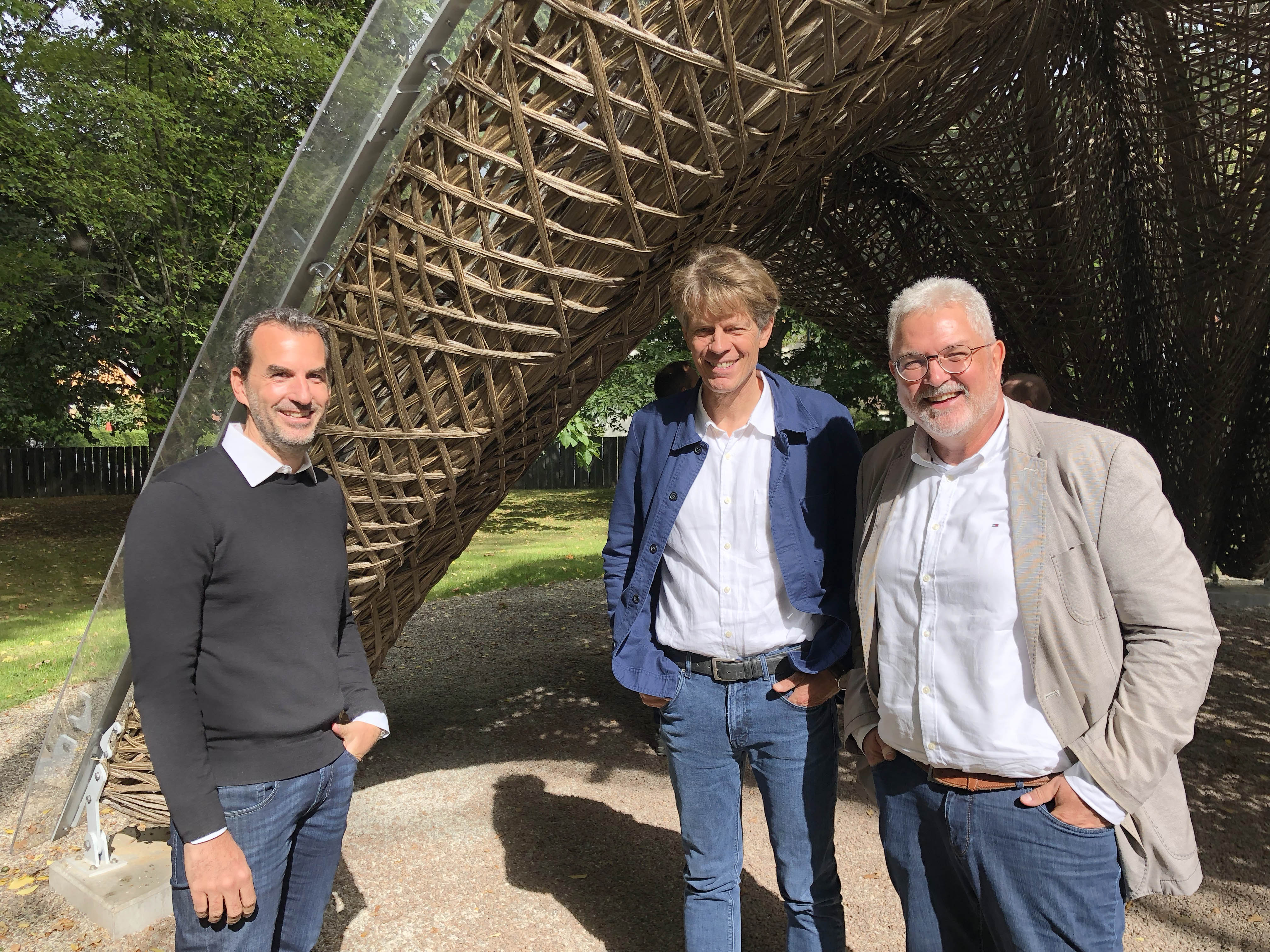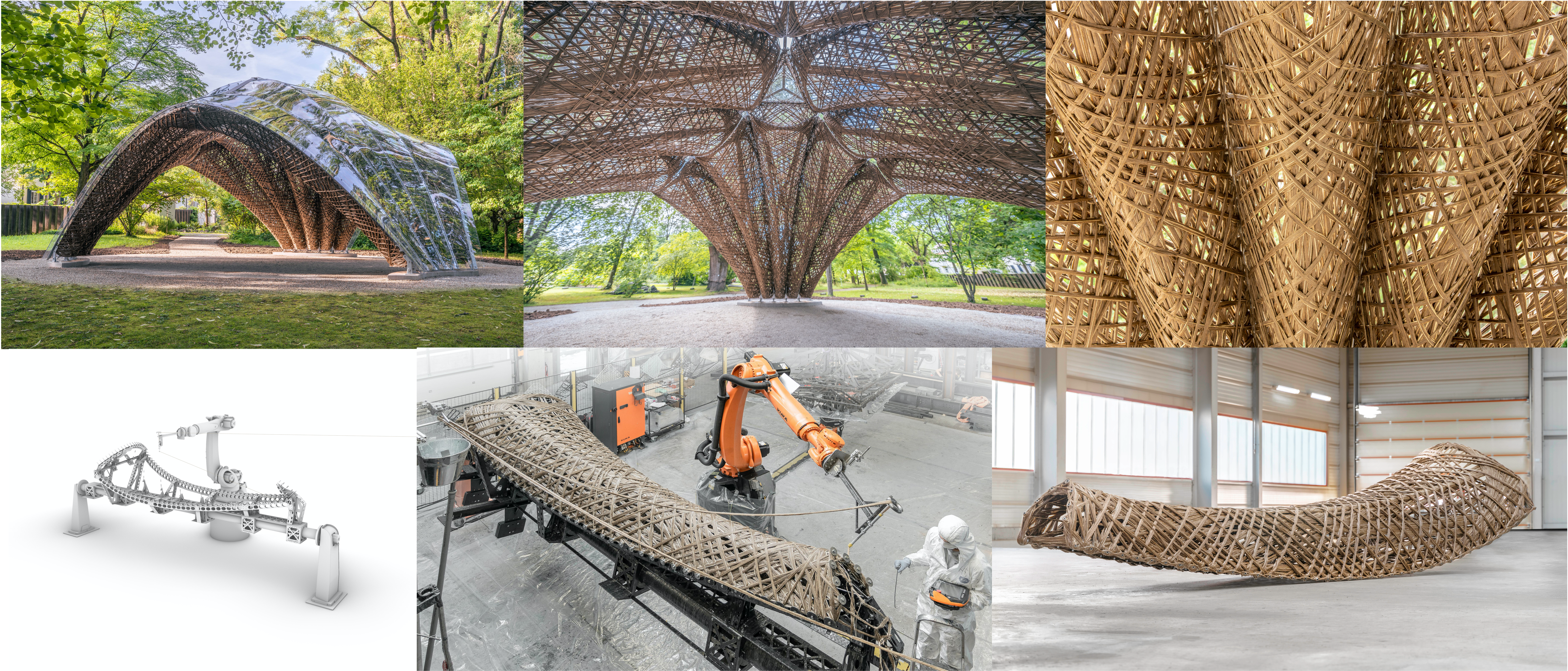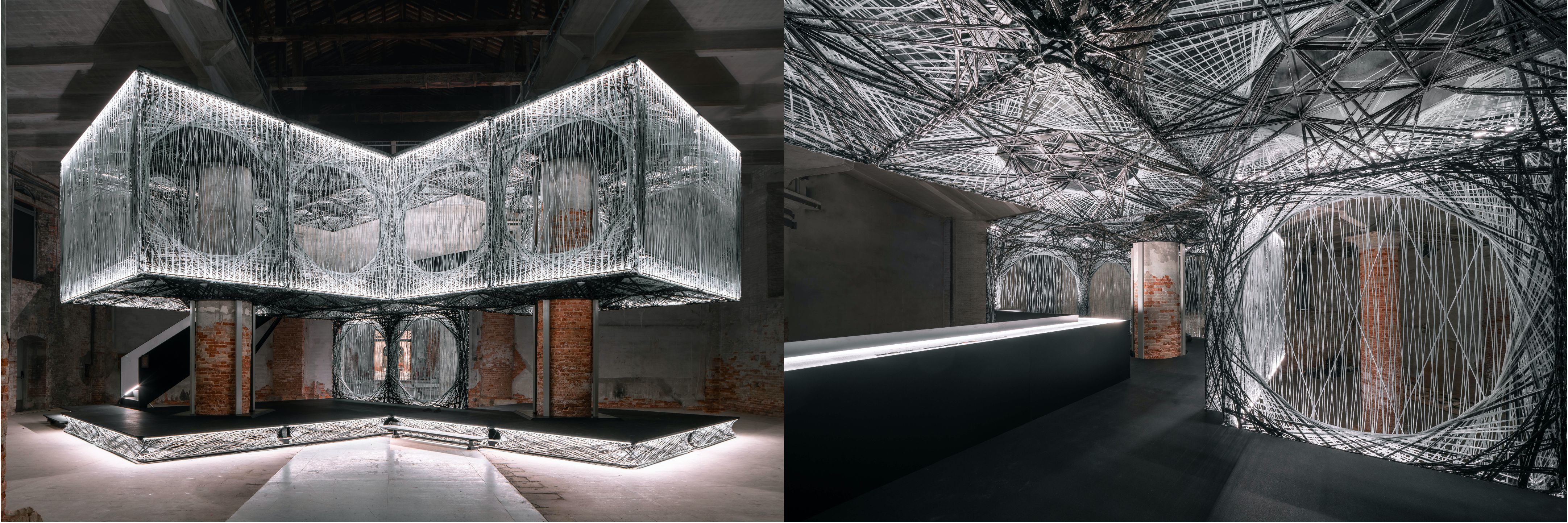Main navigation
Robotic building with natural fibres
One of the greatest challenges in the construction industry is the transition to more environmentally friendly and resource-saving buildings. Researchers at the University of Stuttgart are combining state-of-the-art robotic filament winding technologies with ancient local crops to produce stable and sustainable lightweight structures from flax fibres.
The construction and operation of buildings cause 40 percent of global CO2 emissions, which makes buildings a key target in the fight against climate change. The share of renewable energies in electricity and heat generation has been growing for decades and thus already contributes to reducing greenhouse gases, but environmentally friendly construction is still in its infancy. Six to eight percent of the total annual amount of CO2 caused by construction is released just from the burning of limestone (CaCO3) to produce cement. "This is unavoidable because it is process-related. We therefore need to replace concrete with biobased materials wherever possible," explains Prof. Dr. Jan Knippers from the Institute for Load-bearing Structures and Structural Design (ITKE) at the University of Stuttgart.
Flax as an alternative building material
The thing that immediately comes to mind when talking about environmentally friendly buildings is wood, which is already frequently used in the construction of multi-tier buildings and interior construction. Innovative beacon projects in this area have been funded by the Baden-Württemberg government through various programmes since 2014. However, the major disadvantage of wood is that it has extremely long growth cycles and can also become unusable due to fires or infestation by pests. "So we need to think about alternative biobased building materials. These should have annual growth cycles, not compete with food production and be available locally," says Knippers listing the criteria. "Flax or hemp fibres have been shown to be suitable for this purpose."
Flax, also called linseed, is one of the oldest plants cultivated by humans and is used for fibre and oil production. As early as the 4th millennium BC, the Egyptians used it to produce linen fabrics. In the course of industrialisation, cotton replaced flax because it was easier to process using machines. However, for some years now linen fabrics have started to be increasingly used again by sectors such as the automotive industry, because linen not only smells good and feels pleasant, but is also very robust, dirt-repellent and regulates humidity and temperature. Flax is relatively uncomplicated to grow: it is an annual plant that does not need special soil, requires significantly less water than cotton and can be grown organically without using pesticides.
Basic structure made of robotically wound fibres

Over the past ten years, Knippers' team, together with Prof. Achim Menges' group from the Institute for Computer-Based Design and Construction (ICD) at the University of Stuttgart, has developed a robotic filament winding technology in which carbon or glass fibres are specifically oriented and used only in the quantity necessary for optimal load transfer. This enables the construction of coreless, filigree lightweight structures that resemble the basic structures of plants. As there is no waste or off-cuts, the production process is very efficient. A pavilion made using this method was presented at the 2019 Federal Garden Show in Heilbronn.
Within the framework of the Integrative Computational Design and Construction for Architecture (IntCDC) centre of excellence founded in the same year and funded by the DFG with Menges and Knippers as spokesperson and co-spokesperson respectively, the researchers transferred the filament winding technology to flax fibres. They were supported by students from the international and interdisciplinary Integrative Technologies and Architectural Design Research (ITECH) master's programme at the University of Stuttgart. This year, students from all over the world and from different disciplines including architecture, civil engineering and materials science are working together on the project. Knippers explains: "This open concept is rather unusual in the German educational landscape, but it has huge potential. Wonderful synergies that generate innovative ideas develop in a protected teaching space in collaboration with the students. Teaching is therefore an important part of what we do."
The switch to flax fibres required some changes in the winding process. In contrast to the endless drawn synthetic fibres, a natural fibre roving consists of many individual short pieces arranged in parallel. So that they are not pulled apart during processing and to prevent the roving from tearing, the tensile forces have to be adjusted and a braided cord has to be incorporated for stability. Before the rovings are wound onto the shaping frame, they are run through a bath of epoxy resin; after curing in the oven, the wound elements are then highly stable. "We can produce very high-performance, long-span and heavy-duty structures with this process, and they are much lighter than concrete constructions," says the engineer, clearly enthusiastic about the process. "Given an identical load-bearing capacity, our elements only weigh 1/25 as much as concrete constructions and consume significantly less material."
livMatS pavilion in Freiburg
For many years now, Menges and Knippers have been involved in an inspiring cooperation with Prof. Dr. Thomas Speck and his team. Speck is the director of the Botanical Garden at the University of Freiburg and member of the spokesperson team for the Living, Adaptive and Energy-autonomous Materials Systems (livMatS) cluster of excellence. The livMatS pavilion was built in 2021 in a cooperative project between the two clusters of excellence with the aim of showing that it is possible to build structures by combining digital technology with biobased materials. The pavilion’s support structure consists exclusively of robotically wound flax fibres. As part of an ITECH project, the students in Stuttgart developed prototypes of the basic elements, while FibR GmbH took on the final production and construction of the pavilion in the Botanical Garden in Freiburg. The pavilion is covered with a waterproof skin made of polycarbonate to protect it from environmental influences. Regular samples will be taken over the next five years to test the material for weathering and UV resistance. Knippers explains: "As the load-bearing capacity of the fibre structures has been convincingly demonstrated, our current research issues are durability and fire resistance. Transferring the technology to general building practice only becomes feasible once these questions have been answered."
Filament winding technology for the sustainable construction of multi-tier buildings
For the Venice Architecture Biennale 2021, the IntCDC cluster of excellence team, in cooperation with FibR GmbH, manufactured a walkable, multi-tier building from carbon and glass fibres that they called the Maison Fibre. A similarly designed enclosed pavilion using flax fibres is being planned for the 2023 Baden-Württemberg Garden Show in Wangen. "We want to show that our filament winding technology meets the requirements of residential construction. Our long-term vision is producing the material directly on the construction site without noise and pollutant emissions," says Knippers describing future plans. "In addition to flax, other fibres that are suitable for this purpose include hemp or, in other regions of the world, sisal and coconut."

